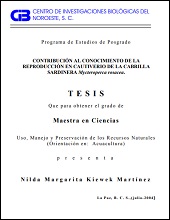Contribución al conocimiento de la reproducción en cautiverio de la cabrilla sardinera Mycteroperca rosacea
Texto completo PDF:
Autor
NILDA MARGARITA KIEWEK MARTINEZ
Metadatos
Mostrar el registro completo del ítemResumen
La cabrilla sardinera Mycteroperca rosacea, perteneciente al grupo de los meros (subfamilia Epinephelinae) es una de las 5 especies de este género presente en el Pacífico. Se distribuye en todo el Golfo de California hasta Jalisco, México. Habita en áreas rocosas cercanas a la línea de costa a profundidades menores de 50 m. La información disponible trata la alimentación natural y la relación edad-talla. Es una especie con importancia comercial en el Noroeste Mexicano y posee alto valor en el mercado. Desde el año 1996, M. rosacea fue introducida en la lista roja de especies amenazadas (IUCN). Los estudios de la reproducción artificial de los meros se vuelven esenciales para lograr una producción constante de juveniles. Varias especies de meros han madurado en cautiverio y han podido ser inducidas hormonalmente al desove. El objetivo del presente estudio fue determinar la maduración sexual en cautiverio, la época de reproducción y el tipo de ovario y lograr la reproducción mediante la inducción hormonal. Los resultados podrán ser aplicados en el cultivo y en programas de repoblamiento de la especie. Los reproductores (n= 22) fueron capturados y mantenidos en cautiverio en 2 tanques de 16 m3 alimentados con sardina y calamar fresco. El peso de las hembras fue de 0.78 y 1.84 Kg y el de los machos entre 1.16 y 2.40 Kg. Se realizaron muestreos mensuales de las gónadas mediante biopsias ováricas. Una porción de la muestra fue analizada en fresco y la otra fue preservada para el posterior procesamiento histológico. Diez hembras fueron inducidas hormonalmente al desove con Gonadotropina Coriónica Humana, primera inyección de 1000 UI•Kg-1 y una segunda inyección 24 horas después de 500 UI•Kg-1. El resto (n= 4) fueron inyectadas con un análogo de la Hormona Liberadora de la Hormona Luteinizante (LHRH-a) (des-Gly10,[D-Ala6]-LHRH) en una dosis de 5 µg•Kg-1 en la primera inyección y 10 µg•Kg-1 tres horas después. De las 10 hembras inducidas con GCh, 6 volvieron a inducirse con la misma hormona 38 días después [...] The Leopard Grouper Mycteroperca rosacea (subfamilly Epinephelinae), is one of the 5 species of the gender in the Pacific. It is distributed throughout the Gulf of California down to Jalisco, Mexico. It inhabits rocky areas close to the coastline at depths 50 m. The information available about the biology of the species is related to the feeding behavior and to the age and growth. It is a specie with high commercial value at the Northwestern of Mexico with an elevated market price. Since 1996, M. rosacea was introduced to the red list of threatened species (IUCN). Studies on artificial grouper reproduction become essential to achieve a sustained juvenile production. There are several grouper species that have matured in captivity and that have been hormone induced to spawn. The objective of the present study was to determine the sexual maturation in captivity, the reproduction period, the type of ovary and to achieve the reproduction by hormone induction. Results of the present study could be applied on the culture and on re-stocking programs. Broodstock (n= 22) were captured and maintained captive in two 16 m3 tanks and fed daily fresh sardine and squid. Female weight ranged from 0.78 to 1.84 Kg and male weight from 1.16 to 2.40 Kg. Every month a portion of the ovary was removed by a gonad biopsy. A portion of the sample was analyzed “fresh” and another was preserved for the later histological procedure. Ten females were hormone induced to spawn with hCG, with an initial injection of 1000 UI•Kg-1 followed 24 h later by 500 UI•Kg-1. The remaining females (n= 4) were induced with LHRH-a (des-Gly10,[D-Ala6]-LHRH) 5 µg•Kg-1 followed by 10 µg•Kg-1 three after later [...]
Colecciones
Ítems relacionados
Mostrando ítems relacionados por Título, autor o materia.
-
PROMOCIÓN DEL PERIFITON PARA EL CULTIVO DE CAMARÓN BLANCO: HACIA UNA ACUICULTURA ECOLÓGICA
DOMENICO VOLTOLINA LOBINA; JUAN MANUEL AUDELO NARANJO; MARIA DEL ROSARIO PACHECO MARGES -
Suelo y Erosión
YOLANDA LOURDES MAYA DELGADO


